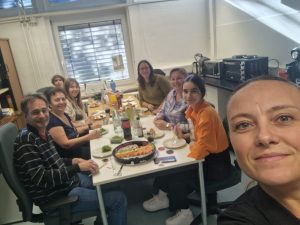12 June 2023
 Asymmetries in size between the left and right sides of the central nervous system are often associated with asymmetries in neuronal organisation. Current literature suggests that variations in the activities of genetic pathways underlie these asymmetries, which in turn may cause variation of behavioural traits.
Asymmetries in size between the left and right sides of the central nervous system are often associated with asymmetries in neuronal organisation. Current literature suggests that variations in the activities of genetic pathways underlie these asymmetries, which in turn may cause variation of behavioural traits.
Anja Bühler from Matthias Carl’s lab of Translational Neurogenetics at CIBIO, University of Trento used a Travelling Fellowship grant from Development to study the impact of brain asymmetry on behaviour in Medaka (Oryzias latipes). Visiting the laboratory of Dr Felix Loosli at the institute of Biological and Chemical Systems at the Karlsruhe Institute of Technology (KIT), Karlsruhe, Germany.
The group has revealed pronounced intraspecies variation of asymmetric gene expression in the habenular network – a highly complex neuronal network with close links to brain disorders such as autism – comparing isogenic medaka strains. To understand a potential link of the differences in asymmetries, Anja had to analyse adaptive behaviours using behavioural assays and generate tools such as in vivo reporters. The Loosli lab has longstanding expertise with medaka as a genetic model system, therefore Anja had a unique opportunity to study population genetics and developmental processes.
“I want to thank the members of the Loosli lab who welcomed me warmly in their group and The Company of Biologists for providing me with this great opportunity.” Anja Buhler, Travelling Fellowship recipient.
During her time at the KIT, Anja gained first-hand experience with medaka behavioural assays, where she would observe the behaviour of the model organism in an open field test to assess their natural exploration behaviour. This test can be paired with a novelty test, in which a novel stimulus is placed into the arena to further observe their reaction to a new object. Both behaviours – exploration behaviour and reaction to novelty – are a measurement of anxiety. This experience has been invaluable as Anja returned to the bench back home in Trento, especially as she is currently establishing and implementing her own medaka behavioural testing.
In addition to this, Anja also designed and injected CRISPR-Cas9 constructs, generating reporter lines, to mark specific and asymmetric distributed neuron populations of the habenular circuit with green, fluorescent protein (GFP) reporter. This technique allows Anja to easily visualize the different neurons in the living medaka larvae, which is an important prerequisite to further study the emergence and the behavioural consequences of brain asymmetry. Anja and her colleagues have already received some positive results: some of the injected embryos showed the expression of the fluorescent marker upon injection.
The Travelling Fellowship experience will enable Anja to continue her investigations of a link between specific brain asymmetries and specific behavioural traits – further elucidating the functional significance of these asymmetries.
Finally, Anja Buhler had the following to say about her unique experience:
“I had a great opportunity to meet and discuss with various members of the working groups situated at the KIT and gained very welcome feedback not only regarding scientific questions but also on personal and career development”.








You must be logged in to post a comment.